By Bojana Coulibaly
Since the resurgence of the DRC conflict, Amnesty International has been an unreliable source of information, breaching research ethics and promoting hate ideology. The latest instance is the fabrication of crimes attributed to the movement M23 in a report published on May 27, 2025 titled “RDC. Le M23 tue, torture et retient des civils en otage dans des lieux de détention” [DRC: M23 kill, torture and hold civilians hostage at detention sites]. The report is signed by Tigere Chagutah, Regional Director of East and Southern Africa at Amnesty International. Two major elements demonstrate that the report is flawed and may not constitute a credible source of information.
Cover photo manipulation by Amnesty International and AFP photojournalist Alexis Huguet

The cover photo of the report by AFP photojournalist Alexis Huguet, seeks to portray Congolese men detained in inhumane conditions to sustain the claim that M23 commits killings, acts of torture and detention of Congolese men in Goma and Bukavu (the two major cities under control of M23 in Eastern DRC).
Amnesty International in fact manipulates a photo taken during the public meeting held in Goma on February 6, following its takeover by M23, at the Stade de l’Unité, where Goma residents rushed to the stadium to celebrate what they saw as their liberation from decades of violence, torture, killings, lynchings, acts of cannibalism, looting, arbitrary arrests, institutional marginalization and divisionism.
As the post on X by The New Times shows (with a video embedded), the meeting was so popular that the stadium could not contain the crowd, and people were squeezed in as they tried to enter the stadium and access the meeting. In fact, minutes after this picture was taken, the wired fence we see in this picture will break due to the size of the crowd contained within it.
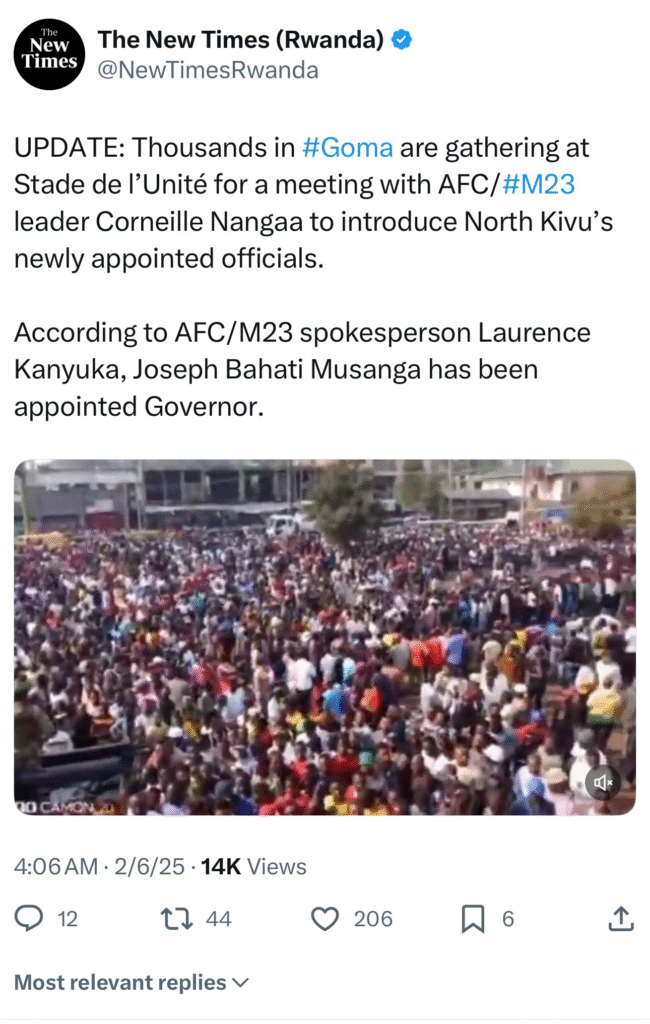
This is not the first time that Alexis Huguet serves, in his capacity as an AFP reporter, to fabricate evidence to back a fabricated crime. He is the photojournalist that claims to have discovered the “14 mass graves” that Human Rights Watch used as “evidence” to support the so-called “Kishishe massacre”. What is striking in the case of Kishishe is that Amnesty International reported in February 2023 that “M23 killed 20 men” in Kishishe in November 2022. It is clear that the term “mass grave” is inadequate in this context and seeks to trigger investigative sensationalism as “20” men cannot be buried in “14” mass graves.
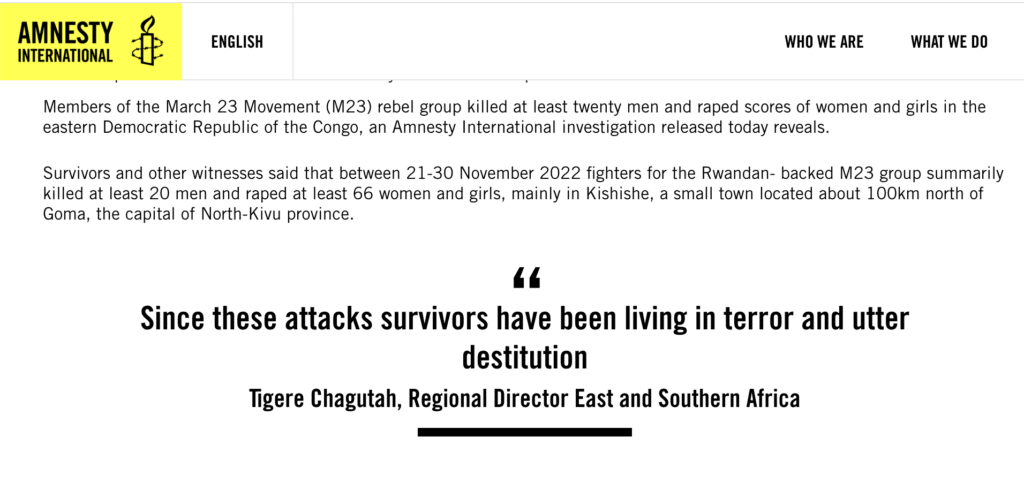
Besides, a photojournalist does not have the professional credentials to determine that the “14 mass graves” that he claims having “discovered” in Kishishe contain the bodies of men killed by M23 in November 2022, when he was on the ground 3 months after the alleged massacre, in other words, when these bodies were in a total stage of decomposition. Only a DNA forensic investigation could have determined when these bodies were buried, how these people died and who are the people buried there. No such scientific investigation has ever been done.
Amnesty International at the service of hate ideology
Another critical element with regards to this report is that Tigere Chegutah does not come to investigate on the ground, but sits behind his desk in Johannesburg and relies on the research done by a designated researcher covering DRC, who himself/herself outsources his/her empirical research in Goma and Bukavu. Of a critical importance here is that the researcher that Mr. Chegutah relies on for his reporting on DRC is Jean-Mobert Senga, a known promoter of anti-Tutsi genocide ideology and who before joining Amnesty International, was an active LUCHA member. LUCHA is a Congolese civil society movement known for its promotion of anti-Tutsi hate speech, and its calls for the ethnic cleansing of Congolese Tutsi. In July 2022, LUCHA organized violent demonstrations against MONUSCO it accused of refusing to kill Congolese Tutsi. The demonstration led to the death of several MONUSCO peacekeepers and over 40 Congolese civilians), as reported in the UN Group of Experts midterm report of December 2022.
Jean-Mobert Senga indeed highlights his affiliation to LUCHA on his X social media platform at the occasion of the 10th anniversary of LUCHA in May 2022.
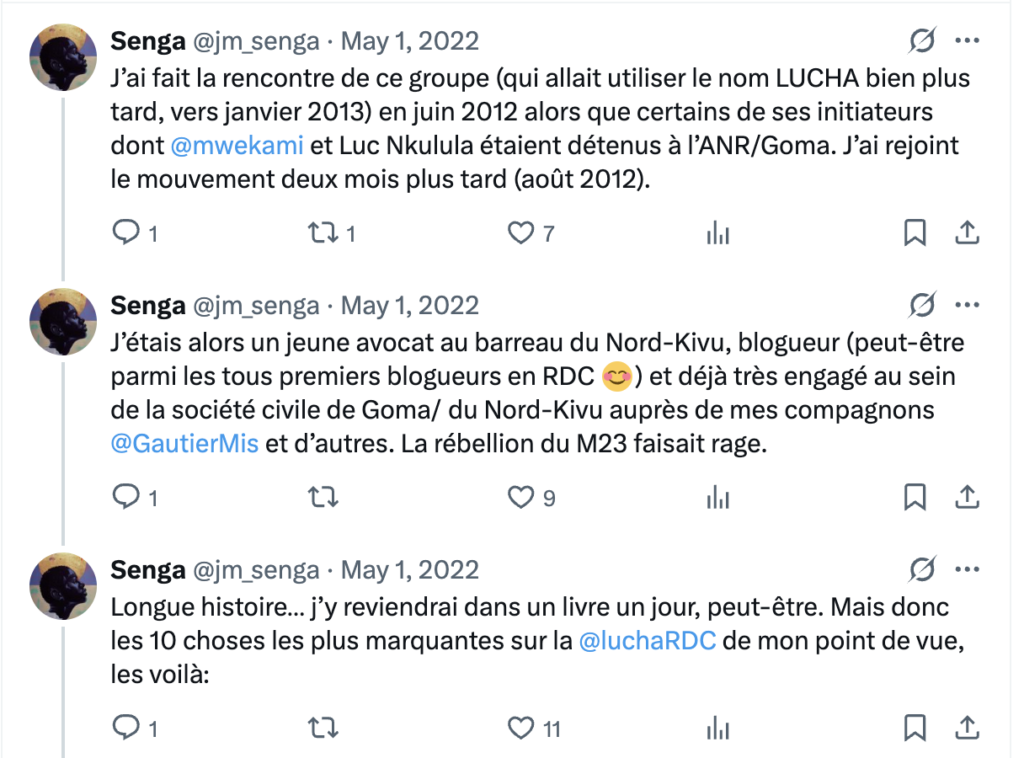
Since Jean-Mobert Senga covers DRC for Amnesty International, he represents Amnesty’s source of information as shown in the below reporting of RFI.
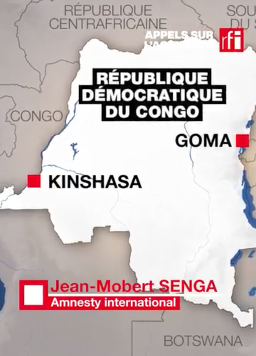
When Senga was both a LUCHA member, and an Amnesty researcher, he has been promoting hate speech, denialism, and hate ideology. This is particularly reflected on his X platform.
In one post in 2014, Senga asks in a provocative tone whether the newly appointed Rwandan prime minister, Anastase Murekezi, is “Hutu” or “Tutsi”, calling it a “taboo” question. Senga is perfectly aware that a divide between artificially created “Hutu” and “Tutsi” “ethnic” and “racial” categories during colonial times, was politically implemented in Rwanda by Belgium during the first half of the twentieth century, leading to the extermination of 1 million Tutsi by Hutu Power militias and a genocidal regime in 1994. The fact of even writing the terms “Hutu” and “Tutsi” as hashtags in his post on X, illustrates Senga’s obsession about these false racial categories created by the colonial explorers and administrators to manipulate ethnic identities for political and economic gain. The kind of tribalist hate rhetoric that Senga engages in, on social media, is dangerous and constitutes hate speech.
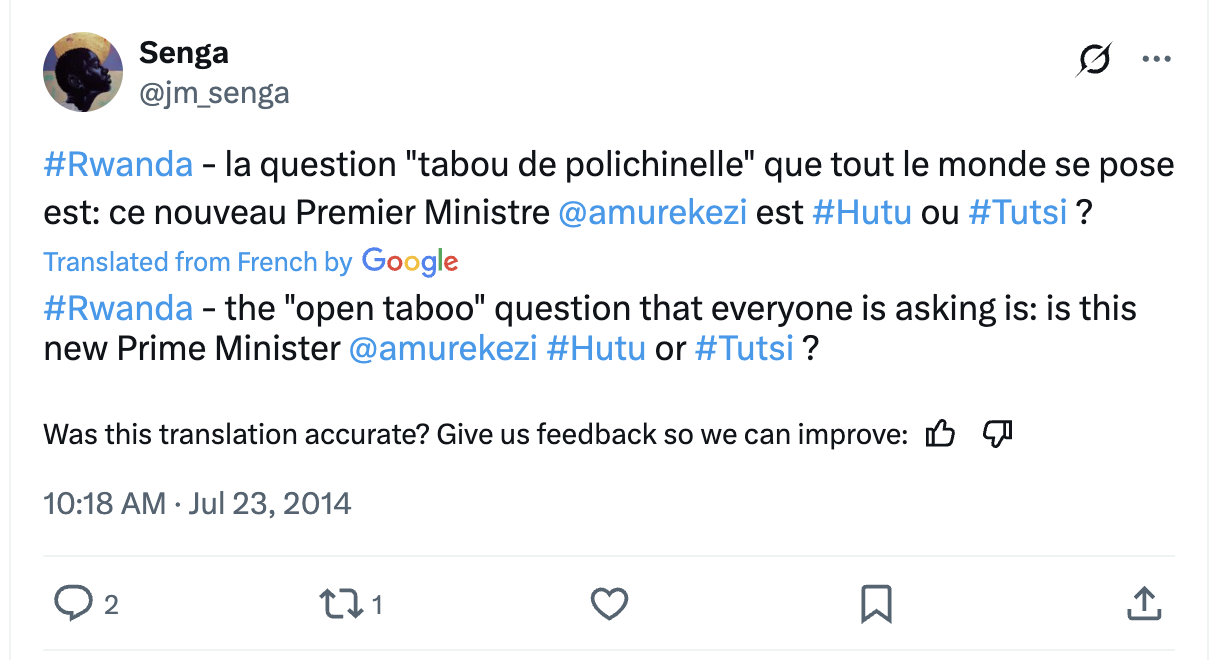
Similarly in a post in 2019, Senga borrows the hate rhetoric which was used in 1959 when Belgium supported and incited Hutu extremists to seize power in a so-called “social revolution”, based on the argument of a numerical “ethnic majority” of “Hutu” over “Tutsi”, which led to anti-Tutsi pogroms, culminating in the 1994 genocide against the Tutsi in Rwanda. In this post, Senga referring to eastern DRC, claims that the power is in the hands of a Tutsi minority, which according to him rules over a Hutu and Nande majority. This rhetoric, used by the masterminds of the genocide against the Tutsi, incites certain groups “to eliminate” others, and this narrative has been at the basis of the persecution, killing, and exile of Congolese Tutsi for decades.
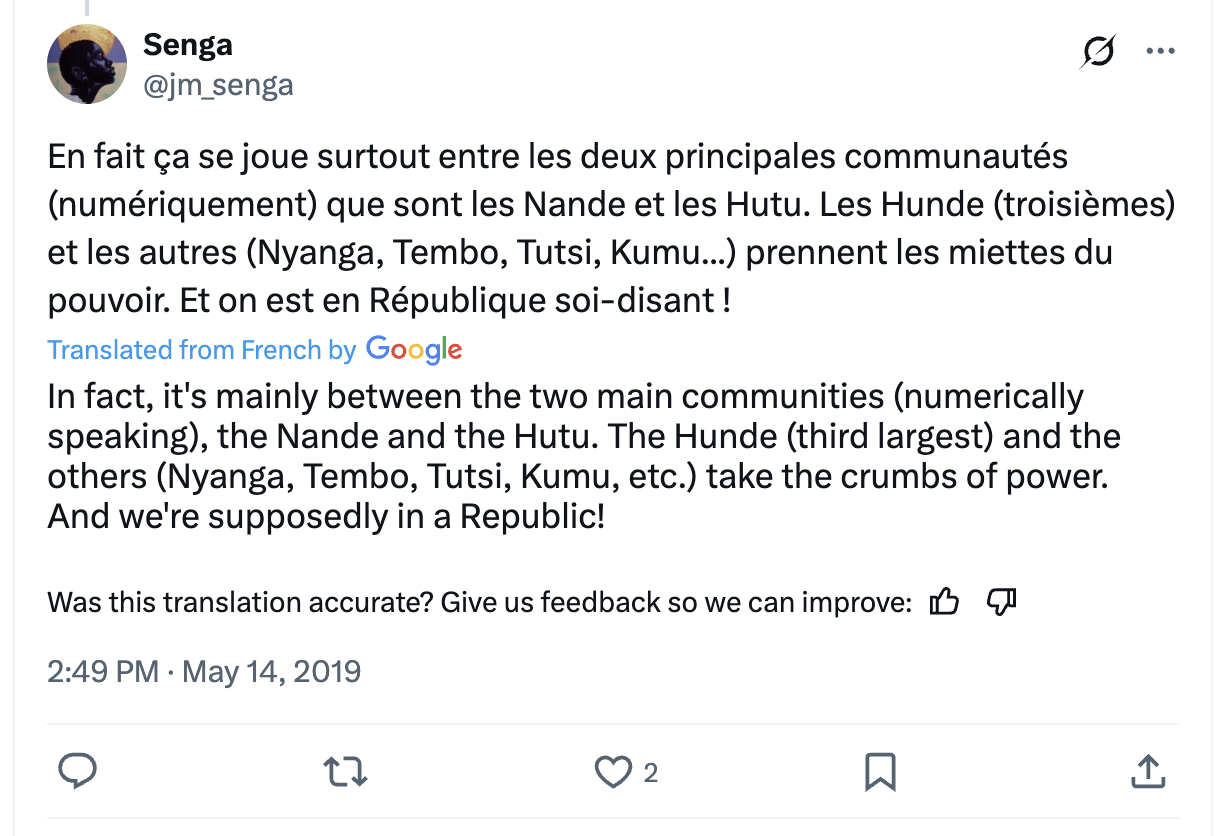
To add to Senga’s promotion of hate speech, he engages in a denialist discourse either supporting common denialist theories or known genocide deniers and ideologues.
In his recent post on the controversial “Solidarité Congo” concert, which was scheduled to be held in Paris on April 7th, the day of the commemoration of the 1994 genocide against the Tutsi, Senga argues that the genocide started on April 6th, and not April 7th. This is one of the main genocide denial theories used by notorious genocide deniers such as Charles Onana, convicted for genocide denial in a French court in December 2024. This theory contends that a genocide was never planned in Rwanda, but that it is the shooting of Habyarimana’s plane, on April 6th, that “sparked popular violence”, which, according to Onana and other deniers, resulted in the mass killings of “Hutu, Tutsi, and Twa.” This allows them to deny genocide, as both the planning of the genocide and the clear identification of the targeted group are erased. This denialist theory has often been used by Congolese officials as an electoral and political tool, to instigate anti-Rwanda hate, and deviate attention from the current Kinshasa’s regime failure.
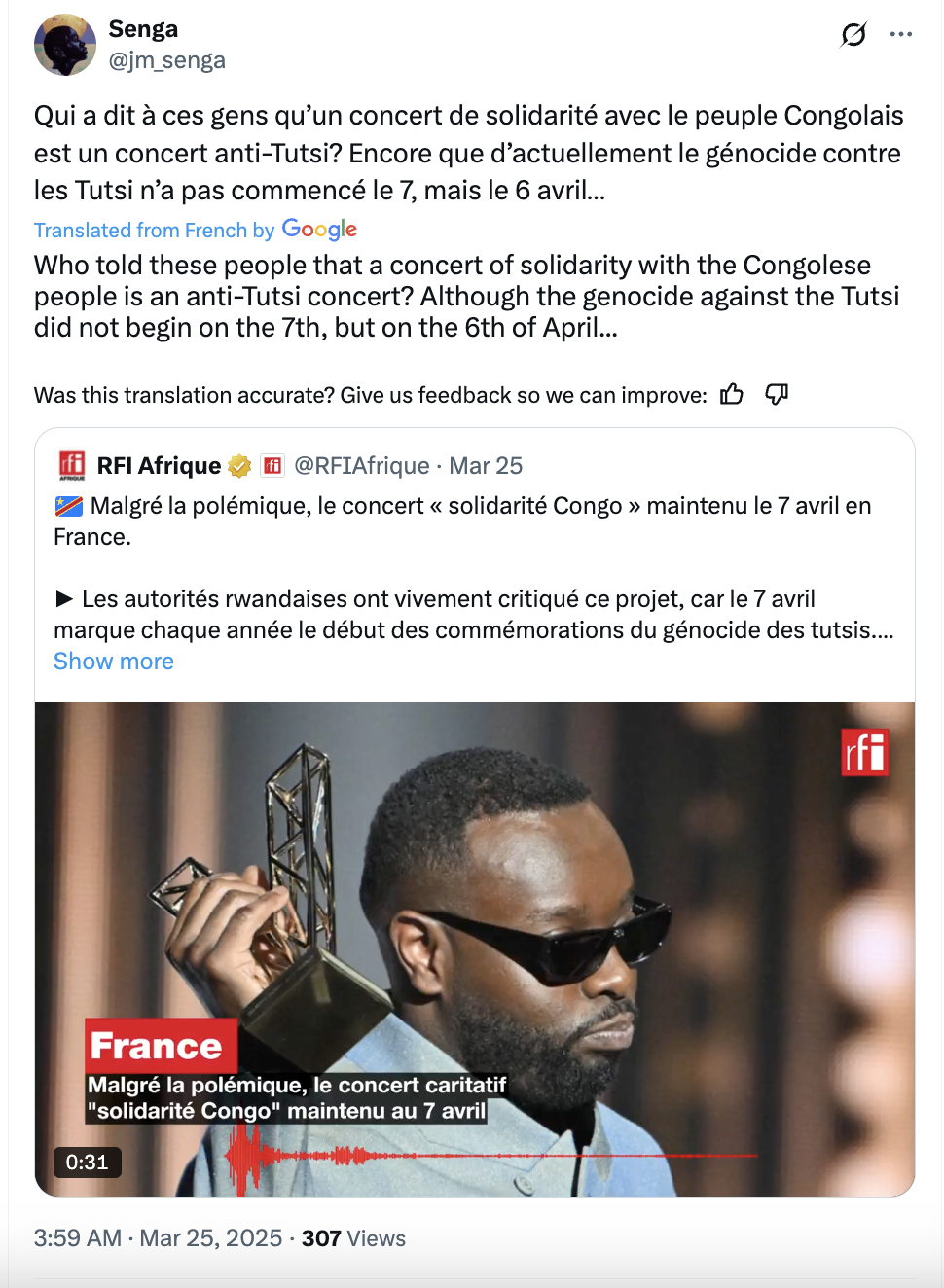
On March 27th, the Congolese ambassador to the UN, Zénon Mukongo Ngay, during a UNSC hearing on the situation in DRC, used this same denialist theory. He was responding to the Rwandan Minister of Foreign Affairs, Olivier Nuhungirehe, who reiterated that the root cause of the current conflict is the collaboration between the FDLR and the Congolese government, which represents a security threat for Rwanda. The Congolese ambassador responded that “the genocide started with the assassination of president Habyarimana. That is the origin of today’s conflict.” He is implying here that, it is not their collaboration with FDLR which is the cause of the current conflict, but the idea, which the Congolese government has consistently supported in the last 3 years, that Rwanda wants to “expand its territory”, in other words, to create “a Hima-Tutsi Empire”. This use of a conspiracy theory and the complete distortion of facts serve the Congolese ambassador and the government he represents, to whitewash their collaboration with the genocidal force FDLR and their endorsement of FDLR-Interahamwe genocide ideology.
Senga in this post not only fails to acknowledge that the date chosen for the concert constitutes a direct attack on the memory of 1 million people killed in the genocide, on the grief of their families and of survivors, but he also fails to denounce that the choice of the lead artist invited to perform at the concert, Maitre Gims, constitutes a problem in itself, as he is a known hate speech activist.
The artist has indeed openly used anti-Tutsi hate rhetoric in a song in which he stated that “it’s not orange juice that can calm the hatred of a Tutsi”. This statement constitutes hate speech as it designates an entire group, i.e., the “Tutsi” or those perceived as “Tutsi”, as “natural born haters”.
Maitre Gims is also known for the hate rhetoric directed at the Rwandan Head of State, Paul Kagame, who led the Rwandan Patriotic Army, which stopped the genocide against the Tutsi in July 1994. In another song, the artist says that “Kagame rime avec croix gammée” [Kagame rhymes with swastika]. This sustains the anti-Tutsi and anti-Kinyarwandophone hate narrative widely present in DRC, preventing any resolution to the ongoing conflict, and jeopardizing the lives of Congolese Tutsi, as well as of those perceived as Tutsi, based on their physical features. LUCHA’s founder Fred Bauma, and DRC president Felix Tshisekedi, both publicly called Paul Kagame “Hitler”, inciting a hate ideology that Senga here promotes, rather than denouncing it.
Senga’s support for Victoire Ingabire, is another demonstration of his denialism and promotion of genocide ideology. Not only Ingabire was convicted for genocide denial, but she has been cited in a UN report for having supported the genocidal force FDLR, responsible for the violence in DRC in the last 30 years.
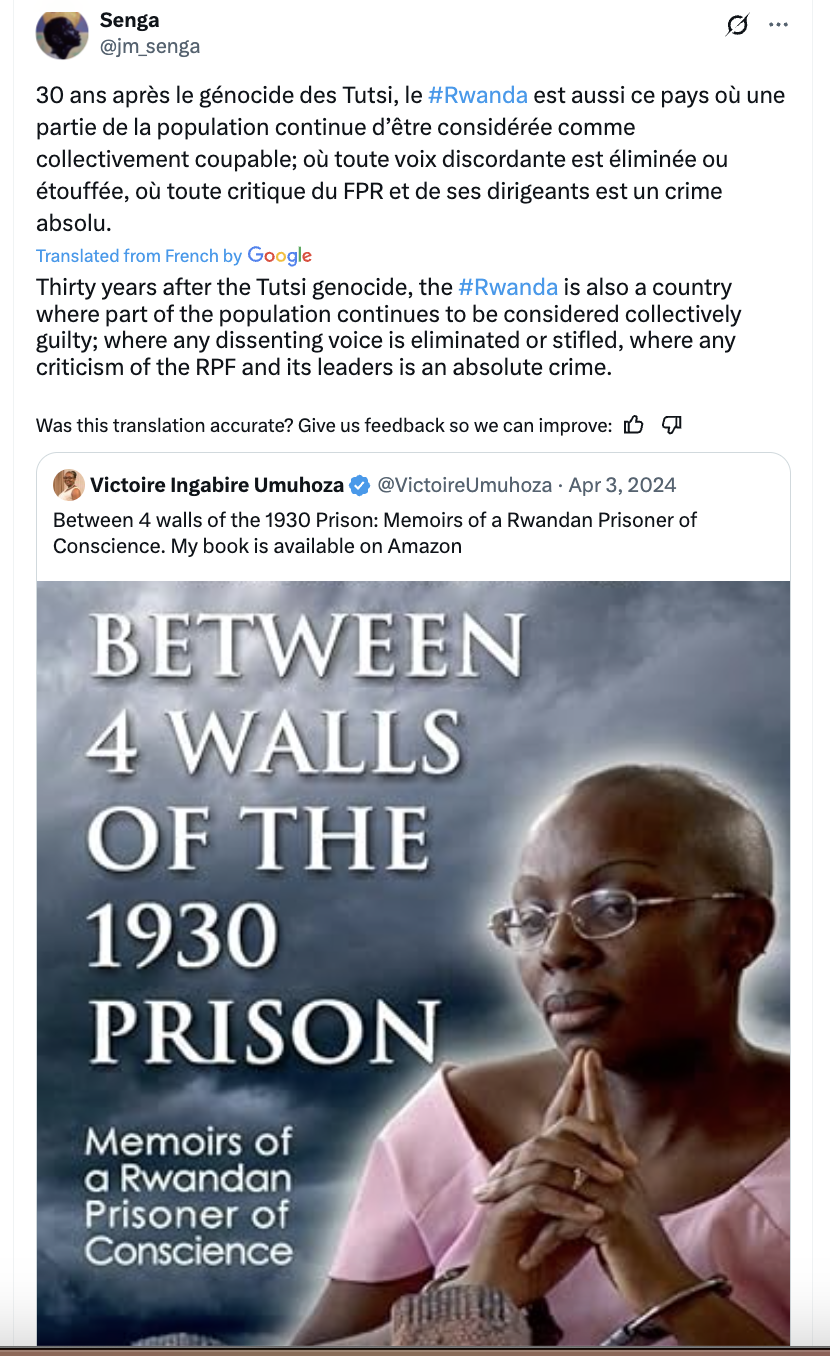
While Victoire Ingabire has been openly promoting anti-Tutsi genocide ideology, supporting the FDLR, and the Wazalendo who have been trained by FDLR and its splinter group Nyatura, to target Congolese Tutsi, Senga here is deploring her alleged experience of “freedom repression” or “censorship” by Rwanda. And yet, Ingabire has not only published multiple times in well-known media, but she is promoting in this X post her own book without being targeted by any form of state censorship, whether of her book or of her X account. This is despite her book directly criticizing the Rwandan government.
What is more, in November 2022, the USG for genocide prevention, Alice W. Nderitu, has denounced the systematic targeting and persecution of Congolese Tutsi, constituting acts of genocide, which added to a number of other reports about the occurrence of lynchings, acts of cannibalism, systematic attacks targeting Congolese Tutsi, their livestock, and property. Senga however, in May 2023 in an X post, attacked Dominic Johnson and Simone Schlindwein, whose reputation as journalists has been recognized thanks to their in-depth reporting on DRC for over a decade and to the seminal book that they co-authored on FDLR. Senga claimed that their warnings of genocide against the Tutsi in Congo, “fuel a narrative that has nothing to do with reality”. He chooses to deny the multiple warnings made by the Congolese Tutsi, while stating that those who denounce their plight are “blood merchants”.
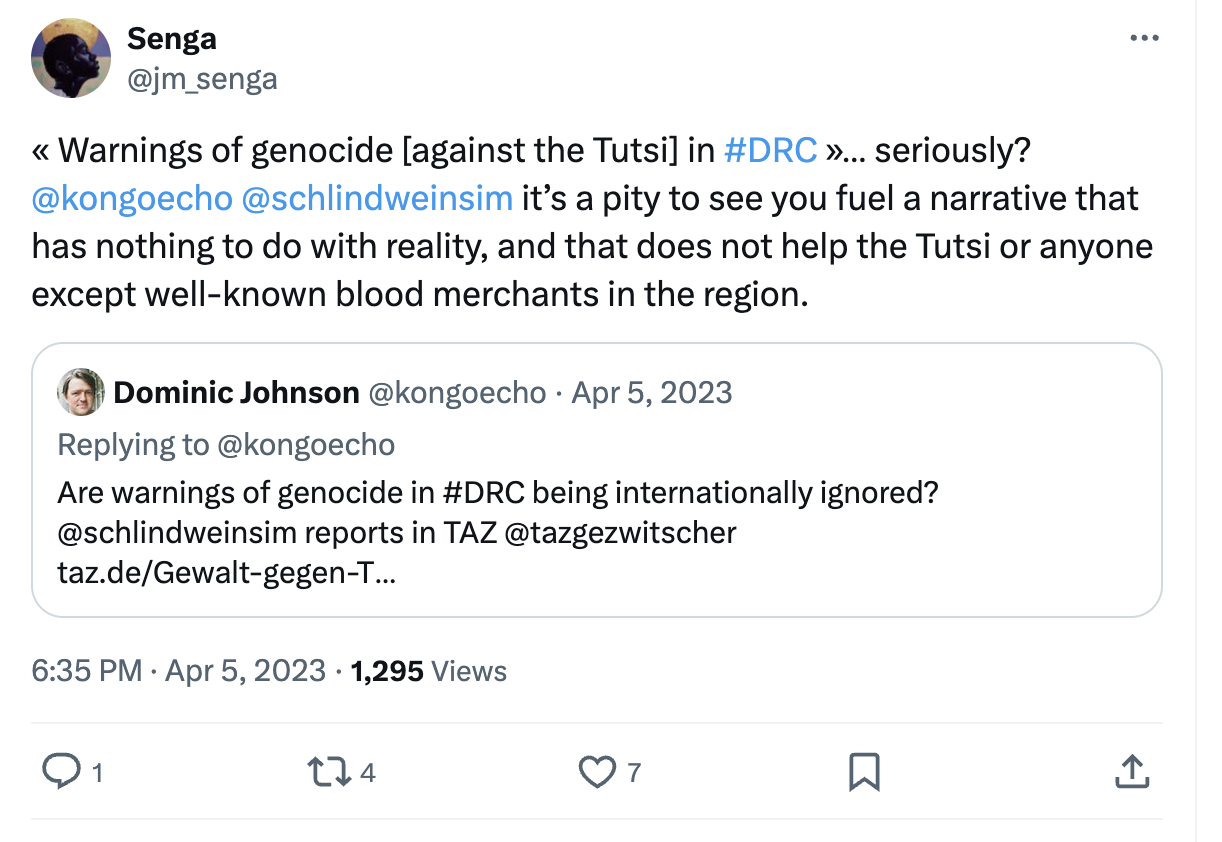
Senga similarly retweeted on March 29, the news update of Radio Okapi, the radio of the UN peacekeeping mission MONUSCO, which used Amnesty International as a source for similarly accusing M23 of “executions, flogging, kidnapping, and extortions”.

The vilification of M23 through LUCHA’s false reporting
This particular campaign of vilification of M23 and Rwanda has been fueled by LUCHA members, who are referred to in the Radio Okapi news update mentioned above as “actors of civil society”, and who have been feeding anti-M23 fabricated reports since M23 has been in Goma, as illustrated on their posts on X.
In one instance they show a video of men in the dark, with one man being beaten with a stick. The poor quality of the video makes it impossible to identify any of the subjects in the video or the group they belong to, if any. The date and exact place where this video was taken is also not provided. So, LUCHA simply posts a message about alleged “acts of torture” and “degrading treatment” “by M23”, with a video that doesn’t show anything.
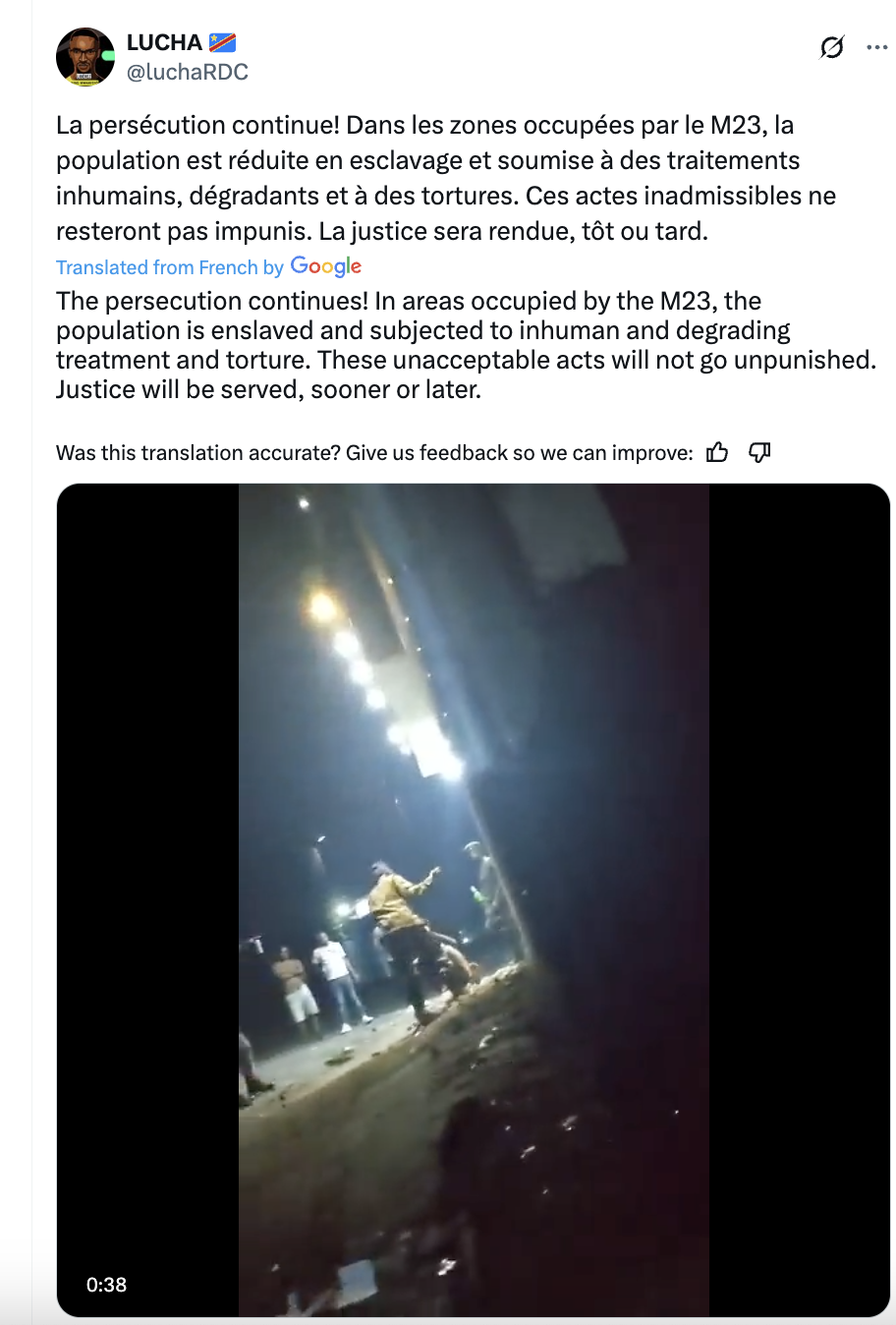
In another instance LUCHA is using a drunkard that they have likely paid to accuse M23 (and Rwanda) of “forcibly recruiting young men in Goma”. This video lacks full credibility as it is failing to show any evidence of forced recruitment by M23.
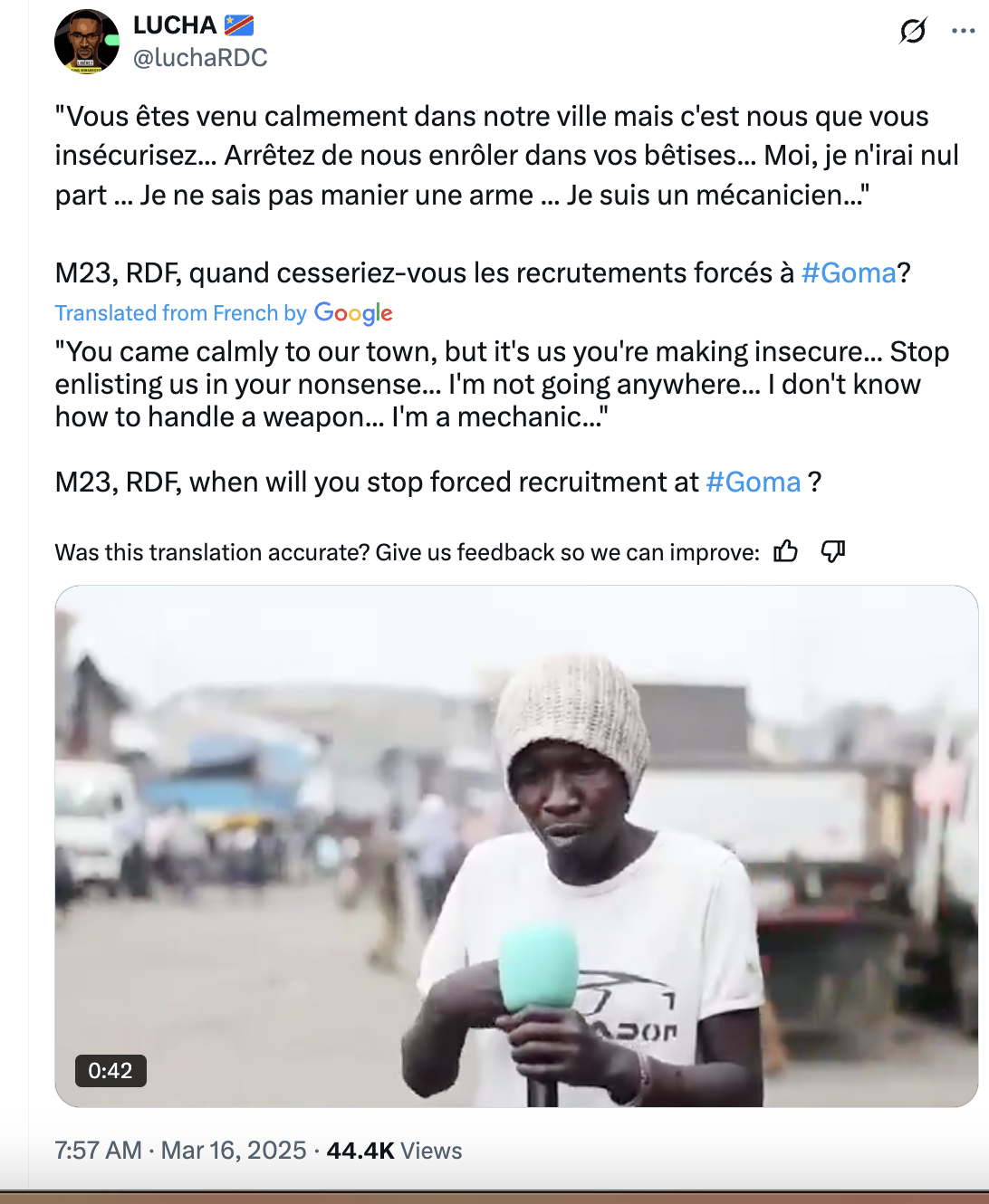
In another post, they are accusing M23 (and Rwanda) of attacking the Heal Africa hospital in Goma without investigating the claim or presenting any evidence.
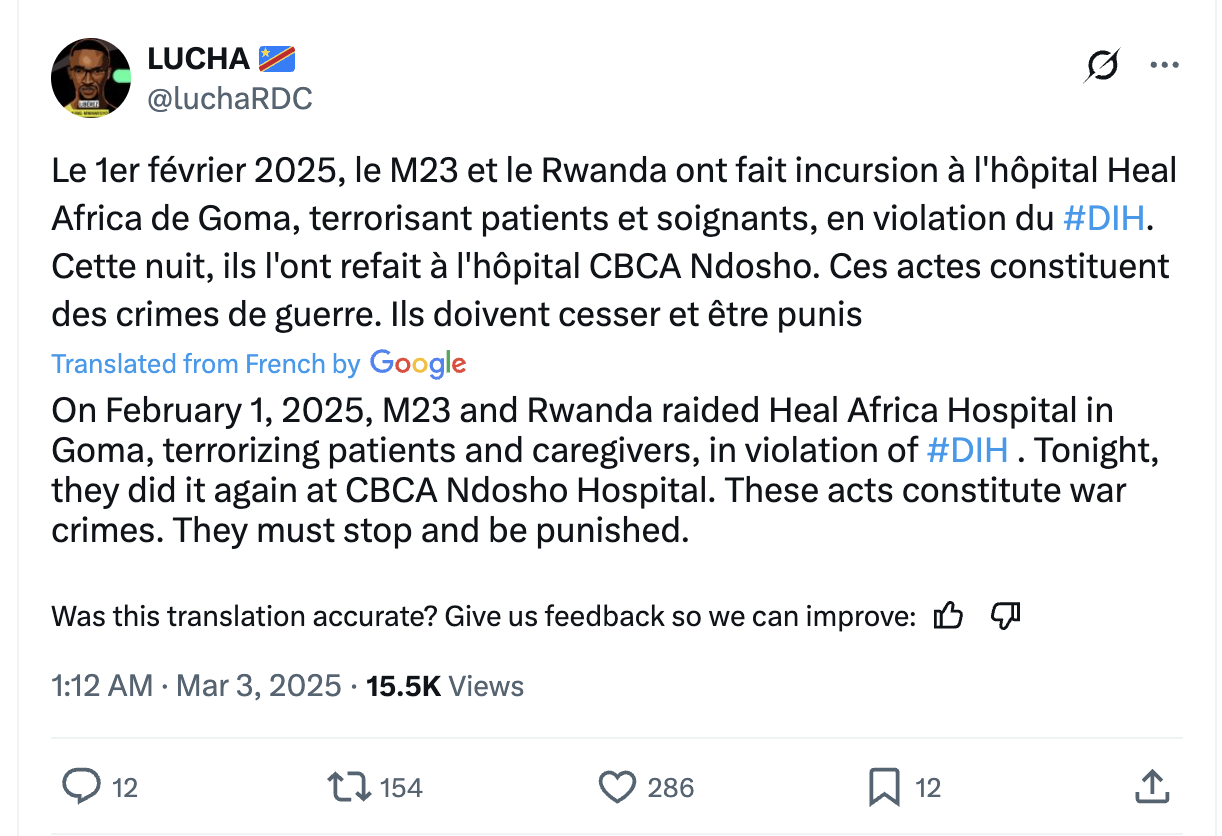
The same goes for the accusation of M23 allegedly killing 4 civil society activists. All the claims are based on rumors that conveniently accuse M23, without ever showing any evidence.
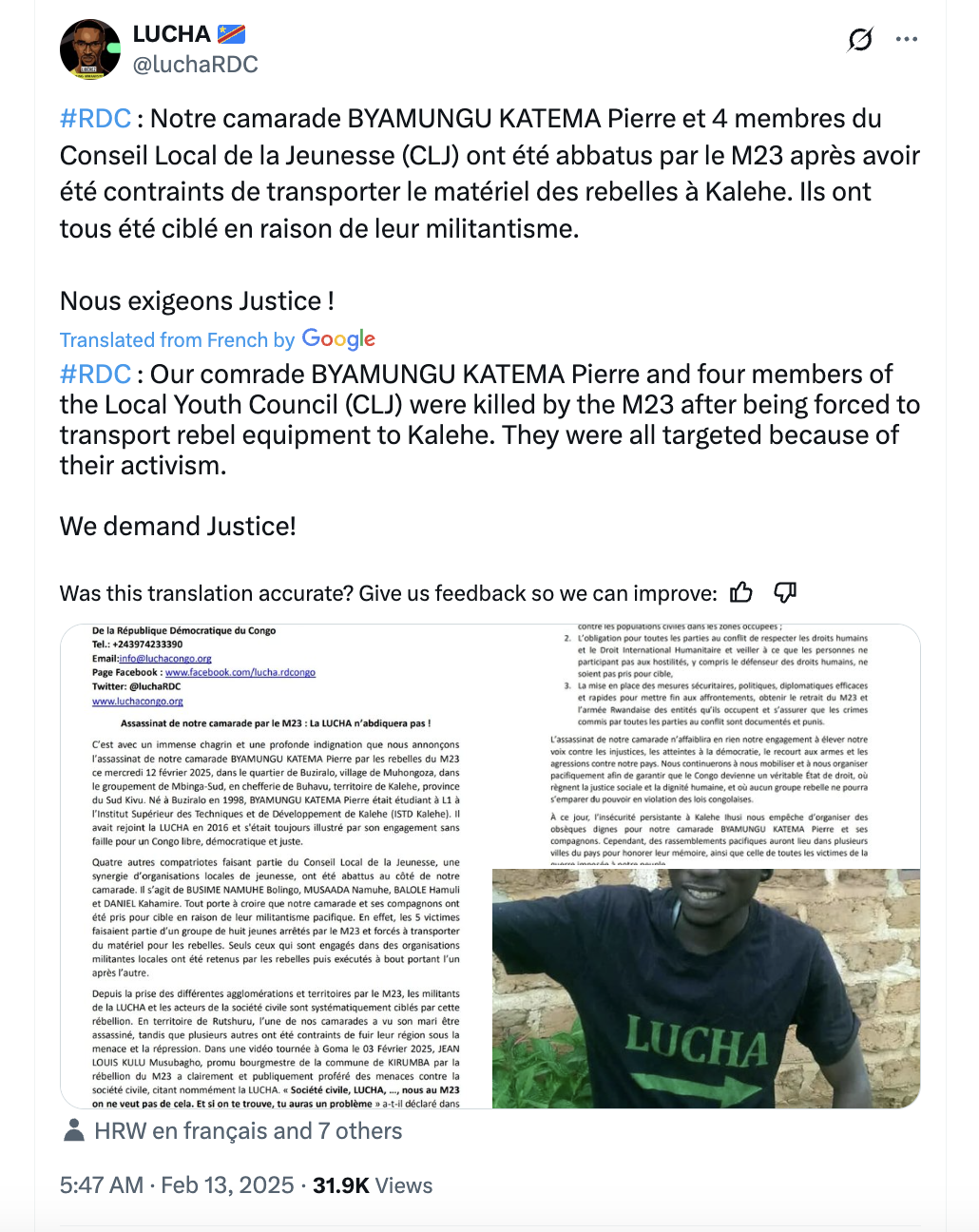
Similarly, the number of “3000 dead in the offensive on Goma” which they are promoting, has been widely contested by journalists and humanitarian organizations. Yet, LUCHA is maintaining the story, equally failing to indicate who the “3000 dead” are.
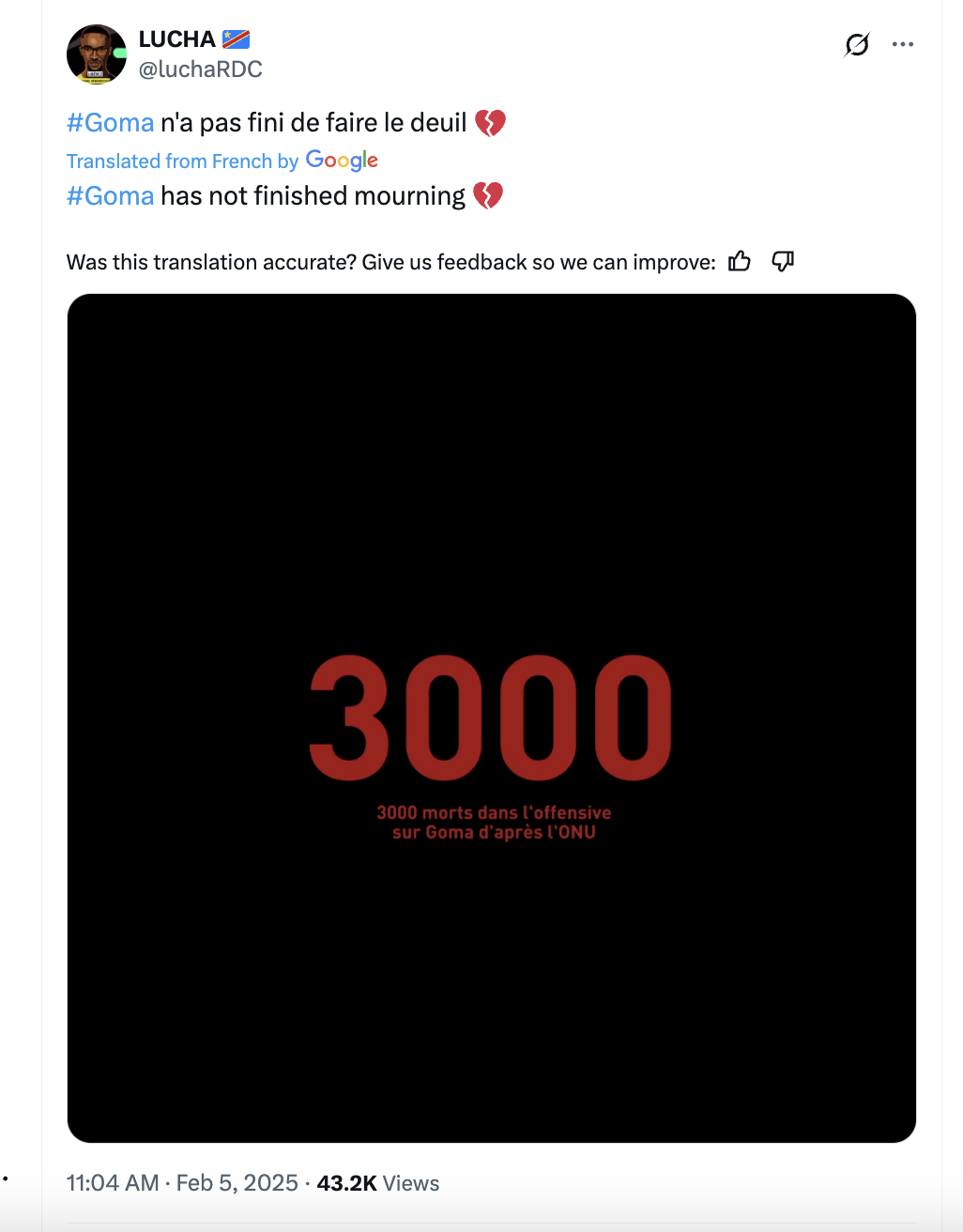
This type of inflation and random reporting of the number of casualties, without investigation and evidence, has been a common tactic used by Kinshasa, in conjunction with LUCHA, Human Rights Watch, and Congo Research Group/Ebuteli, in order to fuel anti-Tutsi, anti-M23 and anti-Rwanda sentiment.